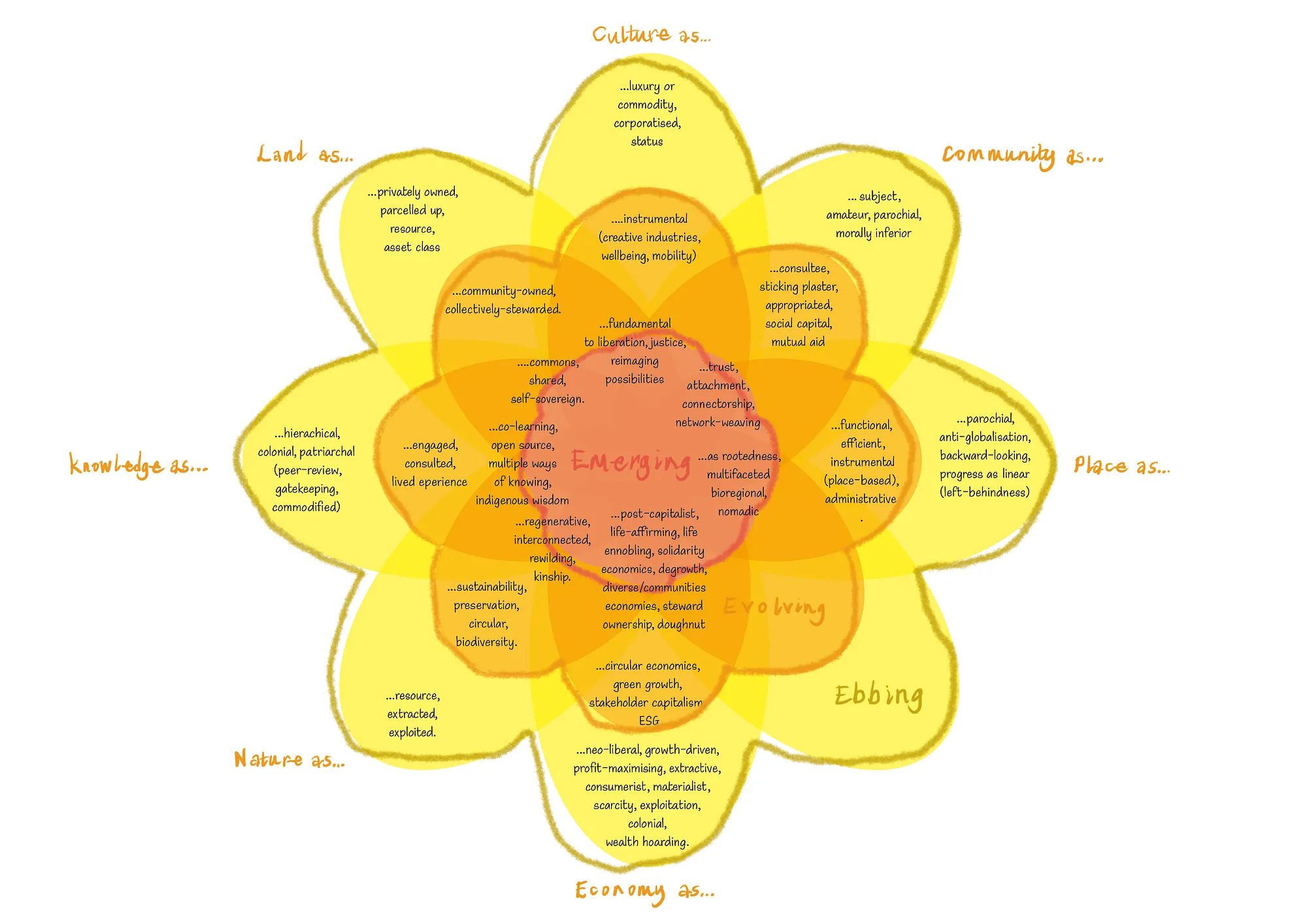The revolution, it turns out, is boringly iterative

Jessica Prendergrast is part of Onion Collective, which undertook an experimental research project last year funded by the Joseph Roundtree Foundation. In this first of a series of four essays, Prendergrast explores new models for transforming systems beyond capitalism, ultimately coming up with a new three-part Ebbing/Evolving/Emerging model they name Onion Collective’s Petal Model of Regenerative Transition.
I like the emphasis on language and metaphor in shaping our understanding of change, as well as the potential for innovation at the periphery of society. It’s a hopeful piece, which is what we need in such times. I’ve included the image of the model which gives some examples, to aid with understanding.
At Onion Collective, positioned as we are in the ‘niche’, the further we delved into system transformation or replacement, the more conscious we became of how all these models, without fail, position the radical as outliers — trying to break in — rather than centre-ing them as dominant forces of change, reinforcing their radicalism as oddity. Whether unintentionally or a symptom of internalised capitalism, this seemed to reflect how anything which challenges the status quo is targeted as ‘radical’ or ‘extreme’. Rebecca Solnit explores this phenomenon in her extraordinary book, Hope in the Dark. She explains how those who are marginalised, especially when they try to push through to the centre, are often portrayed as dangerous and unsavoury, defamed and even criminalised. This was as true for civil rights activists, suffragettes, and abolitionists, as it is now with climate activists and post growth academics. They are portrayed as rabble on the fringe, somehow both naive (or swampy or woke depending on your era) and dangerous — a kind of system-level dismissal or sniggering at those suggesting an alternative to the mainstream, and one which feels particularly galling when that mainstream is creaking (burning, flooding, dying) under the weight of the damage it has created.
[…]
To reflect where the radical power for change really lies, as a starting point, we wanted to convey emerging and alternative futures practitioners less like oddities or outliers and more like a new beginning at the heart of the model. We wanted a model that better represented the viewpoint and power of all those under the waterline (whether in the global south or left-behind places) and that could begin to change what was ‘thinkable’. In the metaphorical battle for hearts and minds, we wanted to find a way to position the dominant but damaging paradigm as on the edge — a far more logical placement in the sense of the ‘extremeness’ of a position that is destroying itself and the planet. And, we put the alternative future in the centre of the action rather than the outskirts of possibility.
[…]
Intentionally, the three rounds of petals are layered up on top of one another reflecting that the new lives alongside the old even as it envelops it and, as we learned from Gibson-Graham, that all sorts of non-dominant regime activity is always happening alongside the mainstream. The layering and overlap also recognises that most of those building alternative futures are operating in what we have described previously as a liminal space. They tend to be working in multiple arenas all at once, and balancing the contradictions and complexities of such all the time. They may be doing a fair bit of ebbing, evolving and emerging work at once, by virtue of existing in the contradictory reality of late-stage capitalism.
The revolution, it turns out, is boringly iterative.
[…]
An example version here shows a host of areas added. In this case, these are petal sets that felt especially relevant to our practice at Onion Collective. For example, our work is at the nexus of culture, community and climate work; it takes in explorations of land use and ownership; knowledge production and sharing and alternative demonstrations of economics in place and at a systems level.
[…]
Viewed from the centre of this flower, where it’s all fresh and new and emergent, far away from the browning decaying edges of the old regime’s petals, it becomes easier to imagine the end of capitalism. From here, to overplay and mix up the metaphors, the ice above the waterline could melt away. From here, looking at all the activity and dreams and hopes that are coalescing under the surface, it’s not so difficult to conceive that maybe, we’ve just been looking in the wrong place, blinded by the light of capitalism. After all, the history of the world tells us that dominant paradigms dominate only until they don’t anymore. Eventually they give way, either gently or in turbulence, to something else. Change is inevitable, new petals will unfurl and a different kind of flower will come into bloom.
Source: Onion Collective
Image: taken from the article